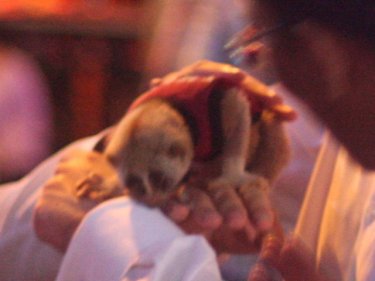PHUKET: We've discovered an expert who knows about slow lorises and can explain to everybody why their treatment on Phuket and elsewhere at Thai tourism destinations is so appalling.
Here's the lowdown on lorises, reproduced with permission from the excellent wildlife site mongabay.com.
BEFORE Anna Nekaris began championing the cause of the world's lorises, little was known about this cryptic family of large-eyed, nocturnal, insect-eating, venomous primates.
Nekaris, with Oxford Brookes University and founder of the Little Fireface Project, has been instrumental in documenting rarely-seen loris behavior, establishing conservation programs, and identifying new species of these hugely-imperiled Asian primates.
''I just fell in love with them. The slender lorises were like googly eyed bananas on stilts, and the slow lorises were like pumped up versions,'' Nekaris told mongabay.com in an interview.
''They always look so crafty when you spot one in the forest, as if they have been watching you for hours, while you have been searching for them. They were considered ugly, brown and boring by most primatologists. Second-rate citizens to the fabulous lemurs.
''But I found out they could race walk as fast as a squirrel could run, their home ranges were the size of 20 football pitches, they could decapitate noxious insects at a rate that would make a French revolutionary proud, and that they loved each other!''
But loris species, some of which are found only on single islands, are facing a barrage of threats. Deforestation across Central and Southeast Asia for monoculture plantations, logging, and other development is devastating loris habitat.
Meanwhile superstitions in some parts of the world lead locals to kill lorises at sight.Finally the illegal pet trade in lorises - exacerbated in part by ''cute'' YouTube videos - is adding a new and particularly cruel threat.
''Sadly during the course of illegal smuggling, most [lorises] die due to stress; the next lot die when their teeth are cut out as not to deliver a venomous bite; the ones that get to their 'owners' die due to environmental stress (wire cage, bright light, loneliness), and horrific malnutrition,'' Nekaris explains.
Nekaris says improved law enforcement, including arrests of buyers and sellers, would rapidly curtail the trade.
There are currently 10 lorises (two slender lorises and eight slow lorises), seven of which have been assessed by the IUCN Red List. Of the seven assessed, six are considered threatened with extinction (two are listed as Endangered and four as Vulnerable).
Mongabay: What's your background?
Anna Nekaris: I have a PhD in biological anthropology. My first field work was with bats in Trinidad and Senegal, followed by paleontological work in Utah. For my undergraduate degree I studied lemurs in captivity. I always knew I wanted to study nocturnal animals so when it came time to choose an animal for my PhD I wanted to study something that no one had ever studied before (but also in a country where I could be vegetarian!) - that meant India, so it was slow or slender loris, and for my PhD and several subsequent years in Sri Lanka I conducted the first long-term studies of slender lorises. I confirmed a new species for Sri Lanka; I rediscovered the Horton Plains slender loris in Sri Lanka in 2002; and I also did work with civets, mouse deer and bats, with some monkeys along the way. In 2001, I came to Oxford where I took the lead of the MSc in Primate Conservation, for which I have been the course tutor ever since. We have about 30 students a year go around the world to study primate conservation.
Mongabay: What drew you to slow lorises initially?
Anna Nekaris: After coming into touch with lorises more because of their locale, I never could look back. I just fell in love with them. The slender lorises were like googly eyed bananas on stilts, and the slow lorises were like pumped up versions. They always look so crafty when you spot one in the forest, as if they have been watching you for hours, while you have been searching for them. They were considered ugly, brown and boring by most primatologists. Second-rate citizens to the fabulous lemurs. But I found out they could race walk as fast as a squirrel could run, their home ranges were the size of 20 football pitches, they could decapitate noxious insects at a rate that would make a French revolutionary proud, and that they loved each other! What I mean is that they were supposed to be solitary, but to see them cuddling, grooming a bit like cats, males playing with babies, sisters playing with young brothers, was to a young primatologist pretty adorable and wonderful. Now we know too that they are venomous and to see them nearly scalp each other in vicious fights, and then miraculously to heal just after a few months when most animals would die . . . they are just full of surprises!
Mongabay: What are the major threats facing this group of primates?
Anna Nekaris: Many people are afraid of lorises and kill them on site; they are surrounded by interesting and mythical stories about how they can hurt or be used in black magic against people.
They are considered to cure over 100 diseases in Indochina - anything from muscle ache, to wound healing to leprosy - a devastating threat that has seen population numbers decline rapidly and even what seems to be in Cambodia localized extinctions.
Others think lorises are cute too and sadly they are one of the most common animals in the SE Asian pet trade. This is trade is also highly localised, so affluent Thai, Indonesian and Chinese keep lorises. The trade to Japan, eastern Europe and the middle east has always been present, but YouTube videos of ''cute'' lorises fuel this trade. Sadly during the course of illegal smuggling, most die due to stress; the next lot die when their teeth are cut out as not to deliver a venomous bite; the ones that get to their 'owners' die due to environmental stress (wire cage, bright light, loneliness), and horrific malnutrition - specialised gummivore/insectivores fed on banana and rice . . . not a good combination.
They also are exploited for the photoprop trade on tourist beaches of islands such as Phuket. Faced with the same problems of pet lorises, 'defanged' lorises are drugged, stressed, malnourished and quickly die before they are replaced by another in clown-like costume.
Mongabay: What do you tell someone who would like a slow loris as a pet?
Anna Nekaris: No primates are pets. They need elaborate social relations. They require a large amount of space to be happy and exercised, which is even difficult to mimic in a zoo much less a home. Their diet is nearly impossible to replicate in captivity and they will die a slow painful death. They are venomous and their bite can kill you; if not you think of children and the elderly who may be more susceptible to anaphylactic shock. So many cute domestic pets are available - rabbits, guinea pigs, hamsters . . . there is no need to drive a species to extinction for human greed and pleasure.
Mongabay: What conservation actions are needed in range countries to protect slow loris habitat?
Anna Nekaris: Enforcement. The loris trade almost always occurs openly in public on busy public streets, even in front of affluent malls and shopping centers, with police and enforcement officers turning a blind eye. If we consider the photo prop trade, those animals are paraded nightly in open streets. Confiscating the animals is not enough - the touts/sellers MUST be prosecuted and made examples of. People do not make that much money from selling lorises. They tend to cost less than a nice bird cage. They are a luxury item, they die quickly so rapid turn over is needed, and stopping the pet trade would not be damaging to anyone in the long-term. In terms of medicinal trade, rural health centers that can provide people with effective medicines over the longer time are the only solution to show that it is 'not only loris medicine that works.' For the affluent people who buy these medicines as status, the same rules apply to them as to traders - both sellers and buyers should be prosecuted.
Mongabay: Will you tell us how the taxonomy of slow lorises has changed in recent decades?
Anna Nekaris: In the early 20th century, loris diversity was recognised with many species. In the 1950s, lorises became one species in a lumping trend. In the 1970s, the very distinct pygmy loris was yet again separated. Lorises do not rely on sharp visual features that diurnal animals use in order to detect mates. It is much more subtle so it is no wonder people thought there were so few species. We now know of eight species, and the number will most certainly rise. These are animals totally constrained by geographic barriers, so do not be surprised to see more genera and more species paralleling that of the gibbons.
Mongabay: What special roles do these primates play in their environments?
Anna Nekaris: Slow lorises are wonderful pollinators. They can feed on the nectar of hundreds of flowers in one night, transferring that nectar several kilometers through the forest. They also are adept insect-killing machines and, adapting well to agroforest habitat, eat pests that harm farmers' crops. Their ability to gouge holes in trees produces a food sources that other animals can exploit.
Mongabay: How could slow lorises lead to a rise in new pharmaceuticals?
Anna Nekaris: The chemical properties of loris venom is still being explored. However, it could be possible that some features of it may yield important pesticides. It may also come to pass, however, that such chemicals are only sequestered from the food they eat and do not come from the loris themselves. More time and research is needed - ask me again in a year!
Mongabay: What can people do to help slow lorises?
Anna Nekaris: Your everyday person can dislike YouTube videos and leave conservation messages asking the uploaders of such videos to take them down. Of course lorises are also devastated by habitat loss largely due to the palm oil industry, so using sustainable products that do not contain palm oil or are RSPO approved is a good step. When on holiday, never take photos with any wild animal used as a prop. Sign petitions when they are available to try to help wildlife trade. Do not buy lorises (or other wild animals) from exotic markets because you feel sorry for them - this only encourages further selling . . . and never never release a bought animal to the wild unless it has gone through an appropriate rehabilitation program. Also wildlife photographers should take care picking up and moving lorises for opportune photos, and anyone on holiday should use a red-filtered light to view the animals, as this does not hurt their eyes or threaten to blind them.
Here's the lowdown on lorises, reproduced with permission from the excellent wildlife site mongabay.com.
BEFORE Anna Nekaris began championing the cause of the world's lorises, little was known about this cryptic family of large-eyed, nocturnal, insect-eating, venomous primates.
Nekaris, with Oxford Brookes University and founder of the Little Fireface Project, has been instrumental in documenting rarely-seen loris behavior, establishing conservation programs, and identifying new species of these hugely-imperiled Asian primates.
''I just fell in love with them. The slender lorises were like googly eyed bananas on stilts, and the slow lorises were like pumped up versions,'' Nekaris told mongabay.com in an interview.
''They always look so crafty when you spot one in the forest, as if they have been watching you for hours, while you have been searching for them. They were considered ugly, brown and boring by most primatologists. Second-rate citizens to the fabulous lemurs.
''But I found out they could race walk as fast as a squirrel could run, their home ranges were the size of 20 football pitches, they could decapitate noxious insects at a rate that would make a French revolutionary proud, and that they loved each other!''
But loris species, some of which are found only on single islands, are facing a barrage of threats. Deforestation across Central and Southeast Asia for monoculture plantations, logging, and other development is devastating loris habitat.
Meanwhile superstitions in some parts of the world lead locals to kill lorises at sight.Finally the illegal pet trade in lorises - exacerbated in part by ''cute'' YouTube videos - is adding a new and particularly cruel threat.
''Sadly during the course of illegal smuggling, most [lorises] die due to stress; the next lot die when their teeth are cut out as not to deliver a venomous bite; the ones that get to their 'owners' die due to environmental stress (wire cage, bright light, loneliness), and horrific malnutrition,'' Nekaris explains.
Nekaris says improved law enforcement, including arrests of buyers and sellers, would rapidly curtail the trade.
There are currently 10 lorises (two slender lorises and eight slow lorises), seven of which have been assessed by the IUCN Red List. Of the seven assessed, six are considered threatened with extinction (two are listed as Endangered and four as Vulnerable).
Mongabay: What's your background?
Anna Nekaris: I have a PhD in biological anthropology. My first field work was with bats in Trinidad and Senegal, followed by paleontological work in Utah. For my undergraduate degree I studied lemurs in captivity. I always knew I wanted to study nocturnal animals so when it came time to choose an animal for my PhD I wanted to study something that no one had ever studied before (but also in a country where I could be vegetarian!) - that meant India, so it was slow or slender loris, and for my PhD and several subsequent years in Sri Lanka I conducted the first long-term studies of slender lorises. I confirmed a new species for Sri Lanka; I rediscovered the Horton Plains slender loris in Sri Lanka in 2002; and I also did work with civets, mouse deer and bats, with some monkeys along the way. In 2001, I came to Oxford where I took the lead of the MSc in Primate Conservation, for which I have been the course tutor ever since. We have about 30 students a year go around the world to study primate conservation.
Mongabay: What drew you to slow lorises initially?
Anna Nekaris: After coming into touch with lorises more because of their locale, I never could look back. I just fell in love with them. The slender lorises were like googly eyed bananas on stilts, and the slow lorises were like pumped up versions. They always look so crafty when you spot one in the forest, as if they have been watching you for hours, while you have been searching for them. They were considered ugly, brown and boring by most primatologists. Second-rate citizens to the fabulous lemurs. But I found out they could race walk as fast as a squirrel could run, their home ranges were the size of 20 football pitches, they could decapitate noxious insects at a rate that would make a French revolutionary proud, and that they loved each other! What I mean is that they were supposed to be solitary, but to see them cuddling, grooming a bit like cats, males playing with babies, sisters playing with young brothers, was to a young primatologist pretty adorable and wonderful. Now we know too that they are venomous and to see them nearly scalp each other in vicious fights, and then miraculously to heal just after a few months when most animals would die . . . they are just full of surprises!
Mongabay: What are the major threats facing this group of primates?
Anna Nekaris: Many people are afraid of lorises and kill them on site; they are surrounded by interesting and mythical stories about how they can hurt or be used in black magic against people.
They are considered to cure over 100 diseases in Indochina - anything from muscle ache, to wound healing to leprosy - a devastating threat that has seen population numbers decline rapidly and even what seems to be in Cambodia localized extinctions.
Others think lorises are cute too and sadly they are one of the most common animals in the SE Asian pet trade. This is trade is also highly localised, so affluent Thai, Indonesian and Chinese keep lorises. The trade to Japan, eastern Europe and the middle east has always been present, but YouTube videos of ''cute'' lorises fuel this trade. Sadly during the course of illegal smuggling, most die due to stress; the next lot die when their teeth are cut out as not to deliver a venomous bite; the ones that get to their 'owners' die due to environmental stress (wire cage, bright light, loneliness), and horrific malnutrition - specialised gummivore/insectivores fed on banana and rice . . . not a good combination.
They also are exploited for the photoprop trade on tourist beaches of islands such as Phuket. Faced with the same problems of pet lorises, 'defanged' lorises are drugged, stressed, malnourished and quickly die before they are replaced by another in clown-like costume.
Mongabay: What do you tell someone who would like a slow loris as a pet?
Anna Nekaris: No primates are pets. They need elaborate social relations. They require a large amount of space to be happy and exercised, which is even difficult to mimic in a zoo much less a home. Their diet is nearly impossible to replicate in captivity and they will die a slow painful death. They are venomous and their bite can kill you; if not you think of children and the elderly who may be more susceptible to anaphylactic shock. So many cute domestic pets are available - rabbits, guinea pigs, hamsters . . . there is no need to drive a species to extinction for human greed and pleasure.
Mongabay: What conservation actions are needed in range countries to protect slow loris habitat?
Anna Nekaris: Enforcement. The loris trade almost always occurs openly in public on busy public streets, even in front of affluent malls and shopping centers, with police and enforcement officers turning a blind eye. If we consider the photo prop trade, those animals are paraded nightly in open streets. Confiscating the animals is not enough - the touts/sellers MUST be prosecuted and made examples of. People do not make that much money from selling lorises. They tend to cost less than a nice bird cage. They are a luxury item, they die quickly so rapid turn over is needed, and stopping the pet trade would not be damaging to anyone in the long-term. In terms of medicinal trade, rural health centers that can provide people with effective medicines over the longer time are the only solution to show that it is 'not only loris medicine that works.' For the affluent people who buy these medicines as status, the same rules apply to them as to traders - both sellers and buyers should be prosecuted.
Mongabay: Will you tell us how the taxonomy of slow lorises has changed in recent decades?
Anna Nekaris: In the early 20th century, loris diversity was recognised with many species. In the 1950s, lorises became one species in a lumping trend. In the 1970s, the very distinct pygmy loris was yet again separated. Lorises do not rely on sharp visual features that diurnal animals use in order to detect mates. It is much more subtle so it is no wonder people thought there were so few species. We now know of eight species, and the number will most certainly rise. These are animals totally constrained by geographic barriers, so do not be surprised to see more genera and more species paralleling that of the gibbons.
Mongabay: What special roles do these primates play in their environments?
Anna Nekaris: Slow lorises are wonderful pollinators. They can feed on the nectar of hundreds of flowers in one night, transferring that nectar several kilometers through the forest. They also are adept insect-killing machines and, adapting well to agroforest habitat, eat pests that harm farmers' crops. Their ability to gouge holes in trees produces a food sources that other animals can exploit.
Mongabay: How could slow lorises lead to a rise in new pharmaceuticals?
Anna Nekaris: The chemical properties of loris venom is still being explored. However, it could be possible that some features of it may yield important pesticides. It may also come to pass, however, that such chemicals are only sequestered from the food they eat and do not come from the loris themselves. More time and research is needed - ask me again in a year!
Mongabay: What can people do to help slow lorises?
Anna Nekaris: Your everyday person can dislike YouTube videos and leave conservation messages asking the uploaders of such videos to take them down. Of course lorises are also devastated by habitat loss largely due to the palm oil industry, so using sustainable products that do not contain palm oil or are RSPO approved is a good step. When on holiday, never take photos with any wild animal used as a prop. Sign petitions when they are available to try to help wildlife trade. Do not buy lorises (or other wild animals) from exotic markets because you feel sorry for them - this only encourages further selling . . . and never never release a bought animal to the wild unless it has gone through an appropriate rehabilitation program. Also wildlife photographers should take care picking up and moving lorises for opportune photos, and anyone on holiday should use a red-filtered light to view the animals, as this does not hurt their eyes or threaten to blind them.

















On Phuket its very fast touts with very slow lorises and even slower enforcement officers with one exception Khun veera exceptional man doing a exceptional job.
Posted by slickmelb on June 7, 2013 04:00